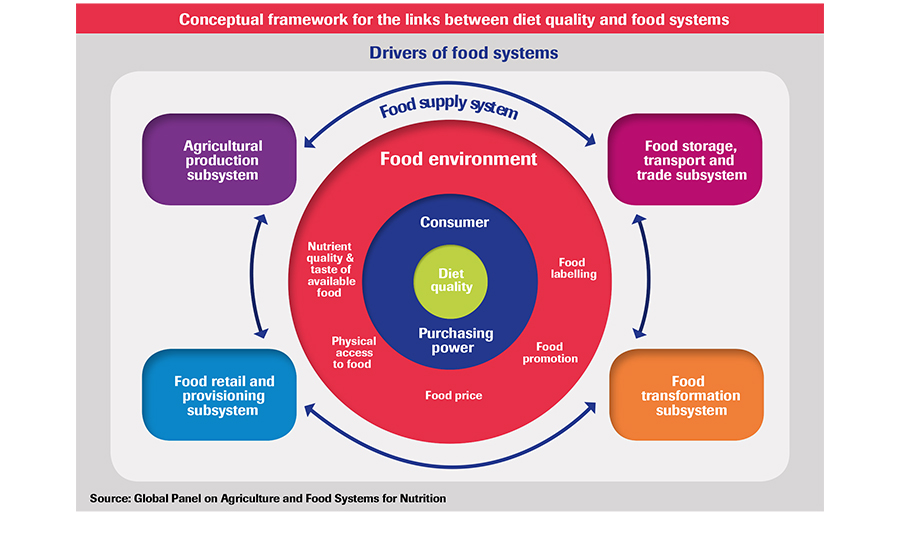Manufacturing News
Modern technology, supply chains not helping worldwide nutrition
The proportion of the world that is suffering from diet-related malnutrition is one in three and, if left unchecked, will increase to one in two.

The diet and quality of food available to consumers depend on consumer purchasing power, the food supply system and the food environment. Source: Global Panel on Agriculture and Food Systems for Nutrition.
The proportion of the world that is suffering from diet-related malnutrition is one in three and, if left unchecked, will increase to one in two, according to a report entitled “Food systems and diets: Facing the challenges of the 21st century,” published by the Global Panel on Agriculture and Food Systems for Nutrition. In addition, if the direction of current governing policies remains the same, estimates suggest that by 2030, the number of overweight and obese people will have increased from 1.33 billion in 2005 to 3.28 billion—or around one-third of the total world population.
Chapter six of the study provides an in-depth look at food systems, which comprise all the processes from farm to fork—more specifically, agricultural production, processing, storage, transportation and retail/provisioning. While agriculture has generally increased food availability, the trend in food systems has been moving away from local systems with short food chains (or supply chains) to global systems, which involve long supply chains with multiple pathways and/or process transformations. In local systems, consumers are close to farm markets and can purchase fresh, unprocessed foods. With long supply chains, consumers are geographically removed from the source of food in its unprocessed state and may rely more on heavily processed foods at retail locations.
Except for high-income countries such as the US and those in Europe, foods produced by agriculture do not necessarily reach consumers in the form in which they are harvested, says the report. Instead, they may be used as animal feed, lost during storage, contaminated with food safety risks or transformed into processed foods. The nature of these changes has important implications for dietary quality. Beyond agriculture, the food supply system influences which foods move through the system and in what form, which are made available and affordable to different people and how safe they are.
Long supply chain models mean that more food is transported, traded and transformed after it leaves the farm, leading to a shift in emphasis away from the farm into “later food supply systems”—sometimes called the “middle of the chain.” These supply chains are increasingly complex and specialized, have strong vertical links between production stages and create an increase in the role and power of the private sector (ranging from farms to transnational corporations) relative to the public sector.
Thus, there is a shift of value, labor and power to the middle of the supply chain. Though still far less than high-income countries (e.g., 85 percent in the US), in low-to-middle income countries, these middle segments have grown to form 30-40 percent of the value added and costs in food value chains. Human labor in agriculture remains extensive, although the development of mechanical, chemical and biological technologies has enabled substitutions for labor in the field. There has been a trend away from processing food at home to the middle of the chain, reflecting shifts toward the use of technology in food preparation, as well as additional food processing and preparation in the food system.
All processed foods require an investment in technology and facilities to produce them. The problem is that in many cases in low- and middle-income countries, a large proportion of the dollars invested in processing goes to foods with the least nutritional value, for example, grain-based foods, snacks and confectioneries. For example, in Latin America, the market shares of the four largest firms in the carbonated soft drinks and sweet and savory snacks markets are more than 60 percent. These issues are coupled with the fact that agricultural products (e.g., corn) grown locally is used either for animal feed or converted into HFCS. Likewise, soy oil is often converted into trans-fat products.
Food supply systems are complex and dynamic. Their influence on diet quality goes well beyond agricultural production into food storage, transport and trade; transformation; retail; and other forms of provisioning. The influence of food supply systems on diet quality occurs via food environments—what food is available and its nutritional quality, price, safety, convenience and promotion. These factors influence how available high-quality diets are to the consumer and how affordable and appealing they are.
While modern food systems are providing opportunities to make foods associated with high-quality diets more available, they are also presenting barriers to greater growth; many changes have occurred that make it easier to deliver foods associated with low-quality diets more available. A critical question is the degree to which the system is supporting the delivery of high-quality diets versus lower-quality diets.
To read the entire 133-page report, visit http://glopan.org/foresight.
Looking for a reprint of this article?
From high-res PDFs to custom plaques, order your copy today!







